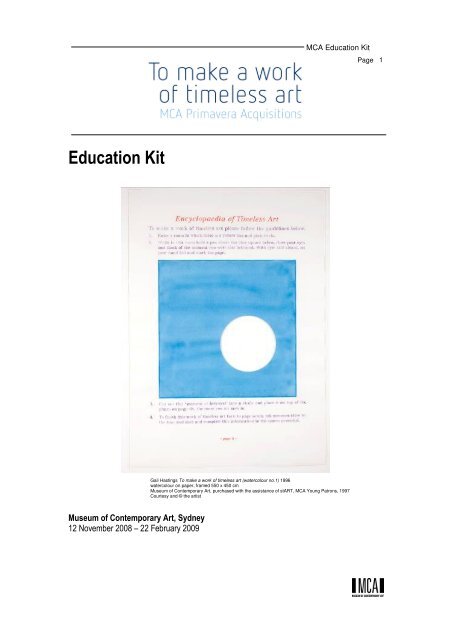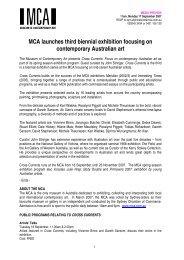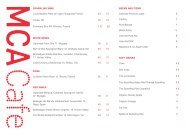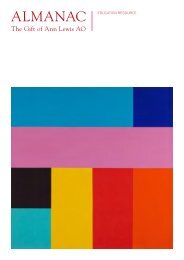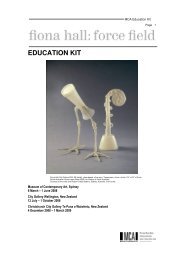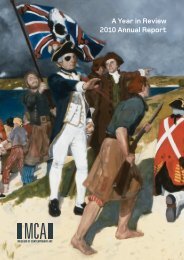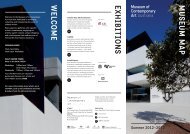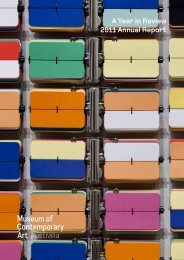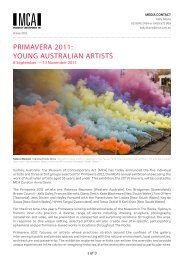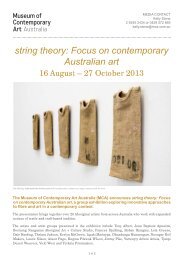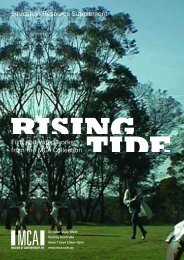Download - Museum of Contemporary Art
Download - Museum of Contemporary Art
Download - Museum of Contemporary Art
- No tags were found...
Create successful ePaper yourself
Turn your PDF publications into a flip-book with our unique Google optimized e-Paper software.
MCA Education KitPage1Education KitGail Hastings To make a work <strong>of</strong> timeless art (watercolour no.1) 1996watercolour on paper, framed 550 x 450 cm<strong>Museum</strong> <strong>of</strong> <strong>Contemporary</strong> <strong>Art</strong>, purchased with the assistance <strong>of</strong> stART, MCA Young Patrons, 1997Courtesy and © the artist<strong>Museum</strong> <strong>of</strong> <strong>Contemporary</strong> <strong>Art</strong>, Sydney12 November 2008 – 22 February 2009
MCA Education KitPage2CONTENTSIntroduction 3About this kit 3Curriculum Connections 3Exhibition Overview 5History <strong>of</strong> Primavera 6Case Study: The MCA Collection 7Focus Questions and Activities: Primavera and the MCA Collection 8The <strong>Art</strong>ists 9<strong>Art</strong>work Analysis 1: Tim Silver Untitled (adrift) 2004 10Focus Questions and Activities 11<strong>Art</strong>work Analysis 2: Lyndal Walker Come as you are 1993 12Focus Questions and Activities 13Case Study & Classroom Activity: Wall Drawing 15Further Questions and Activities 20Glossary 22Further Reading and Resources 24Evaluation Questionnaire 25Acknowledgements 26
MCA Education KitPage3INTRODUCTIONThis online Education Kit has beenproduced by the <strong>Museum</strong> <strong>of</strong> <strong>Contemporary</strong><strong>Art</strong> to support the exhibition To make a work<strong>of</strong> timeless art: MCA Primavera Acquisitions.To make a work <strong>of</strong> timeless art is anexhibition <strong>of</strong> works from the MCA Collectionby artists who have been included in pastPrimavera exhibitions. Established in 1992,Primavera is an annual exhibition series thatfeatures Australian artists aged 35 yearsand under. The exhibition highlights theMCA’s dedication to both collecting andexhibiting works by contemporary Australianartists. It is a celebration <strong>of</strong> the history <strong>of</strong>Primavera and emphasises a keycomponent <strong>of</strong> the museum’s activities—supporting Australian artists and preservingtheir work for future generations.ABOUT THIS KITThis kit provides an insight into key worksand artists in the exhibition and gives anoverview <strong>of</strong> Primavera and the MCACollection. The kit <strong>of</strong>fers information, focusquestions and suggested activities forfurther study. A special feature is the CaseStudy and post-visit lesson plan for walldrawings.This resource is intended for use byteachers and students <strong>of</strong> Primary andSecondary classes, as well as a generalguide for Tertiary and community artsaudiences.The material in this kit is designed forstudents <strong>of</strong> Visual <strong>Art</strong>s and Photographic &Digital Media, but is also relevant for thestudy <strong>of</strong> English, especially for the study <strong>of</strong>Visual Literacy.The kit can be utilised by education groupsengaging directly with the works during theclass excursion as well as individual studyand research. The images, activities andideas can assist with pre-visit preparationand during the gallery visit, and to developpost-visit activities.The material is intended to complement theinformation provided in the exhibitionpublication, the audioguide featuringinterviews with 9 <strong>of</strong> the artists, and theexhibition wall texts.Teachers are advised to adapt theseactivities to suit their students’ needs or tointegrate areas <strong>of</strong> this resource into existingclassroom units <strong>of</strong> study. Focus questionsand activities are included to stimulatediscussion and critical thinking by students,and to lead to a deeper investigation <strong>of</strong> theissues raised by the artists.Key terms are defined in the glossary at theend <strong>of</strong> this kit. A guide to additional readingand resources has been provided to assistwith further study.CURRICULUM CONNECTIONSTeachers are encouraged to adapt syllabuslinks from the list below to suit the system <strong>of</strong>their school’s state. Use these suggestionsas a starter for planning, or talk to MCALearning staff for further ideas.To make a work <strong>of</strong> timeless art is the idealcontext for the study <strong>of</strong> <strong>Art</strong>ist’s Practice, theConceptual Framework and the Frames(especially the Postmodern and StructuralFrames) at Secondary level. The range <strong>of</strong>materials and methods in the exhibition alsoprovides an engaging introduction toknowing about, and making, contemporaryart for Primary level students.For the NSW Visual <strong>Art</strong>s syllabus, To makea work <strong>of</strong> timeless art is an ideal exhibition
MCA Education KitPage4for developing case studies, investigatingthe practice <strong>of</strong> emerging artists and studyinga Body <strong>of</strong> Work. The study <strong>of</strong> this exhibitionin a museum environment provides avaluable opportunity to look at theConceptual Framework, and study theFrames through engaging with works <strong>of</strong> art.See the Focus Questions and Activitiessections for further syllabus-linked teachingand learning ideas.Visual <strong>Art</strong>s/Creative <strong>Art</strong>s• The role <strong>of</strong> the <strong>Contemporary</strong> <strong>Museum</strong>• Working in series, developing a Body <strong>of</strong>Work• Conceptual Framework—<strong>Art</strong>ist, <strong>Art</strong>work,Audience, World• Exposure to a range <strong>of</strong> artistic practice• Process• Diversity <strong>of</strong> media and techniques• <strong>Art</strong> and politics, art and current events• <strong>Art</strong>ist’s Practice• <strong>Art</strong> History, <strong>Art</strong> Criticism• Postmodernism: appropriation andrecontextualisation, language and text,multiple readings, humour and irony• <strong>Art</strong> which is challenging and provocative• <strong>Art</strong> and politics, art and current events,art and personal histories• Photomedia• Sculpture, sculptural processesincluding maquettes• Allusions to popular culture• Photography as documentation – truthand artifice• The moving image – video andinstallation• Multimedia presentationsSociety and Environment• Visual arts as a reflection <strong>of</strong>contemporary culture• Visual arts as a reflection <strong>of</strong> cultural orpersonal identityESL/NESB/CALD• Developing a visual arts vocabulary list• Written and oral responsesMCA EDUCATION PROGRAMSTo book a group visit to the MCA to viewTo make a work <strong>of</strong> timeless art or forinformation on education programs andservices linked to this exhibition contactMCA Learning education@mca.com.au02 9245 2484 or www.mca.com.au/educationEnglish• Analysing Visual Texts• Oral and research skills• Response to visual stimuli• Creative writing and response• Critical essays and reviewsPhotographic & Digital Media; Timebased<strong>Art</strong>s
MCA Education KitPage5EXHIBITION OVERVIEWTO MAKE A WORK OF TIMELESS ART:MCA PRIMAVERA ACQUISITIONSTo make a work <strong>of</strong> timeless art presents aselection <strong>of</strong> works in the MCA Collection byPrimavera artists. Established in 1992,Primavera is an annual MCA exhibitionseries that features Australian artists agedthirty-five years and under and celebratesthe vitality <strong>of</strong> emerging art practices.To make a work <strong>of</strong> timeless art takes its titlefrom one <strong>of</strong> Gail Hastings’ ‘sculpturalsituations’. It reflects the idea <strong>of</strong>‘timelessness’ as a condition that is ongoingor in flux—rather than a completed state. Itis significant to the acquisition <strong>of</strong> emergingartists’ work for a <strong>Museum</strong> collection, as itprompts us to consider artistic and curatorialprocesses across time. The tension between'timelessness' and a permanent <strong>Museum</strong>collection <strong>of</strong> ‘emerging’ artists has been animportant consideration during the exhibitionresearch and the selection <strong>of</strong> works. Ideassurrounding artistic and studio process andthe notion <strong>of</strong> time passing have also formeda distinct thread within the exhibition.One <strong>of</strong> the strengths within the MCACollection is its support <strong>of</strong> ephemeral orinstruction-based works <strong>of</strong> art. KerriePoliness’ Red Matter Wall Drawing #2 hasbeen recreated from an instruction bookacquired by the MCA in 1995, and thepreliminary watercolour produced by AndrewMcQualter for his wall-painting in the MCACollection is also on display. James Angus’maquette <strong>of</strong> Manta Ray created todetermine the final design <strong>of</strong> a larger-scalesculpture, reveals the <strong>of</strong>ten unseen aspects<strong>of</strong> studio practice.A number <strong>of</strong> featured artists explore ideassurrounding time: Tim Silver’s Untitled(adrift) documents the dissolution <strong>of</strong> a smallboat over the course <strong>of</strong> ten photographs.Vicente Butron captures a painted ‘action’conducted in 1994 and Lyndal Walkercelebrates the perpetual reinvention <strong>of</strong> artand fashion through her ‘grunge’ sculptureCome as you are. Shaun Gladwell’s videouses slowed motion to draw attention to thebody in relation to the urban environmentand Felicia Kan reveals traces <strong>of</strong> the worldturning in her photographs, stars, moon andsky. The exhibition has also provided theopportunity for artists to ‘revisit’ their worksin the Collection. Mikala Dwyer, DavidRosetzky and Lyndal Walker have reworkedtheir installations, and some componentshave been loaned to contextualise MCACollection pieces.The exhibition is accompanied by a freeaudioguide—available from the informationdesk on level one—which contains brief,informative interviews with nine <strong>of</strong> theexhibited artists.Isabel Finch & Clare LewisCurators, To make a work <strong>of</strong> timeless art 1This exhibition is dedicated to the memory <strong>of</strong> the late DrEdward Jackson who contributed so much to thePrimavera exhibition series.1 From the introductory exhibition wall text, Isabel Finch and Clare Lewis
MCA Education KitPage6HISTORY OF PRIMAVERAThis annual exhibition <strong>of</strong> work by Australianartists 35 years and under was founded in1992 through the generous benefaction <strong>of</strong>Dr Edward and Cynthia Jackson, and theJackson family, in memory <strong>of</strong> their latedaughter Belinda, a talented artist andjewellery designer.Primavera means “spring” in Italian. Eachspring, this unique MCA exhibition providesa showcase for a new selection <strong>of</strong> youngtalent. Since the exhibition was initiated,nearly 100 emerging artists who work in arange <strong>of</strong> media have been given opportunityto display their work to diverse audiences.For many <strong>of</strong> the artists this is their firstexhibition in a museum.Each year’s Primavera may have a differentdirection or theme. Each year, a curator isinvited to select artists that they feelrepresent current trends and art makingstyles emerging in a new generation <strong>of</strong>artists.Since 2003, the <strong>Museum</strong> has renewed afocus on acquiring works for its collection.Works by artists featured in Primavera are afocus <strong>of</strong> the MCA’s acquisitions strategy.This initiative is also supported by theJacksons.2004 MCA Curator: Vivienne Webb. Theme:The use <strong>of</strong> everyday objects and materialsin work by young Australian artists. <strong>Art</strong>ists:Nick Mangan, Natasha Johns-Messenger,Huseyin Sami, Sandra Selig, pvi collective,Roy Ananda, Julia Robinson, Tim Sterling,Sangeeta Sandrasegar and Neal Smith.2005 Guest curator: Felicity Fenner. Theme:<strong>Contemporary</strong> responses to landscape.Monika Behrens, Madeleine Kelly, FionaLowry, Danie Mellor, Tom Mùller, YukultjiNapangati, Michelle Ussher, PedroWonaeamirri, Jemima Wyman.2006 Guest curator: Aaron SeetoBenjamin Armstrong, Fergus Binns, Julia deVille, Matthew Griffin, David Griggs,Christian de Vietri, Chayni Henry, KatherineHuang, Rob McHaffie, Peter McKay, KojiRyui, Simon Yates, Wilkins Hill.2007 MCA Curator: Christine MorrowPatrick Doherty, Honor Freeman, BrieleHansen, Anthony Johnson, JustineKhamara, Jess MacNeil, Amanda Marburg,Katie Moore, Martin Smith.2008 Guest curator: Hannah MathewsMarcus Canning, Danielle Freakley, ArielHassan, Mark Hilton, Paul Knight, Pilar MataDupont & Tarryn Gill, Moya McKenna, Ms &Mr, Gemma Smith, Soda_Jerk.Recent Primavera curators, themes andartists include:2003 Guest curator: Julianne Pierce.Theme: The use <strong>of</strong> new technologies anddigital media. <strong>Art</strong>ists: Daniel Crooks, AlexDavies, Adam Donovan, Shaun Gladwell,Stephen Honneger & Anthony Hunt,Jonathan Jones, The Kingpins (Emma Price,Katie Price, Técha Noble and AngelicaMesiti) and Mari Velonaki.
MCA Education KitPage7CASE STUDY: THE MCA COLLECTIONThe MCA Collection began with the<strong>Museum</strong>’s constitution in May 1989. Since1991 the MCA has managed and cared forthe J. W. Power collection for the University<strong>of</strong> Sydney. This collection was accessionedbetween 1967 and 1989 so, although theMCA has only held a permanent collectionsince 1989, it does cover contemporary artfrom much earlier. There are over 5000works in the two collections –the J.W. PowerCollection and the MCA Collection. Togetherthese are referred to as “the MCACollection”.The J.W. Power CollectionThis collection comprises artworksaccessioned from 1967 to May 1989, thedate the <strong>Museum</strong> <strong>of</strong> <strong>Contemporary</strong> <strong>Art</strong> wasconstituted. The J.W. Power collection is thelargest <strong>of</strong> the collections held by the MCA.Within the collection are 1,103 paintings, oilsketches and drawings by John Powerhimself, as well as a variety <strong>of</strong> works byother artists, predominantly international,including kinetic work from the 1960s and1970s, op art, pop art, minimalist works, andmore recent works from 1980s.Included within the J.W. Power collection isthe Ramingining Collection <strong>of</strong> Aboriginal <strong>Art</strong>.This collection <strong>of</strong> over 200 bark paintingsand wood carved sculptural and functionalobjects was brought together between 1981and 1984 by curator Djon Mundine when hewas an arts adviser at Ramingining, a smallcommunity in Arnhem Land.The MCA CollectionThis collection comprises work acquiredafter 1989 until the present. It includes:The Arnott’s Collection <strong>of</strong> Aboriginal BarkPaintings: A collection <strong>of</strong> 285 bark paintingsdonated in June 1993 by Arnott’s BiscuitsLimited and features work by Aboriginalartists from the late 1960s through to theearly 1980s.The Loti and Victor Smorgon Collection <strong>of</strong><strong>Contemporary</strong> Australian <strong>Art</strong>: Donated to theMCA in 1995 by private collectors Loti andVictor Smorgon, this collection <strong>of</strong> 154 worksis a remarkable survey <strong>of</strong> work <strong>of</strong> the 1980sand 1990s by Australian artists spanningseveral generations.The Maningrida Collection <strong>of</strong> Aboriginal <strong>Art</strong>:Maningrida is an Aboriginal community inArnhem Land in northern Australia, halfwaybetween Darwin and the Gove Peninsula.This collection <strong>of</strong> objects by Maningridaartists is held in trust on a long-term basis bythe MCA in agreement with the ManingridaCommunity.<strong>Contemporary</strong> <strong>Art</strong> Archive: <strong>of</strong>fering abroader understanding <strong>of</strong> art practice, theArchive includes works <strong>of</strong> art and otherrelated source materials that are <strong>of</strong>tenoverlooked by conventional histories andmuseum collections–but which give valuableinsight into artists' work and their thoughtprocesses.Why does the MCA have a collection?The collection is crucial to the MCA as itdefines it as an art museum: an institutionthat acquires, houses, cares for and protectsan evolving collection <strong>of</strong> art works. Itcontributes to the MCA’s unique position asa museum dedicated to collecting as well asexhibiting the art <strong>of</strong> today. The collection isan invaluable resource for exhibitions andloans, and for future generations.Collecting is an essential part <strong>of</strong> the MCA’scommitment to supporting contemporaryAustralian artists. Through on-going care,documentation, conservation and storage
MCA Education KitPage8the MCA ensures that these works, andtherefore the story <strong>of</strong> Australian art, will bepreserved.How does the MCA develop its collectionand acquire new works?The MCA's collections developmentcommittee convenes each quarter to discussproposed purchases, donations, andbequests to the MCA collection. Theacquisitions committee comprises theDirector, Head <strong>of</strong> <strong>Art</strong>istic Programs and theCurators.Proposed purchases and donations undergoa critical evaluation process by the MCA’scollections development committee, and areassessed on the basis <strong>of</strong> their significanceand relevance to the collection and itsparameters; as well as broader artistic,financial, conservation and storageconsiderations.What is meant by ‘recent acquisitions’?‘Recent acquisitions’ refers to worksacquired by the MCA over the past 12months or so.What was the first work acquired for theMCA collection?The earliest accessions for the MCACollection were in May 1989, and includedtwo bark paintings by John Marwundjul.Focus Questions and ActivitiesCurate your own exhibition <strong>of</strong> young artists,selecting students from your class. Whatconnections can you make between theirwork?Trace over one year how the MCArepresents its collections publicly throughexhibition programs at the <strong>Museum</strong> orthrough tours. What recurring themes doyou see? What message do you think theMCA is giving through the works selected inthese exhibitions?Look through the list <strong>of</strong> artists featured inPrimavera. Which ones have madesubstantial art careers since the exhibition?Research a Primavera artist from each yearand track the developments <strong>of</strong> their practicesince they first showed in Primavera.Make a case study <strong>of</strong> Primavera as a longstandingregular feature in the MCA’sexhibition calendar. How does the exhibitionreflect or influence the MCA’s overallobjectives and collection strategy? Can yousee any recurring threads or themes acrossseveral Primavera exhibitions? See theMCA website under ‘The <strong>Museum</strong>’ and todownload the Annual Reports forbackground information.Explore the collection or exhibition history <strong>of</strong>your local art gallery or museum, or localdealer galleries. Have they featured work byany <strong>of</strong> the artists who have shown in pastPrimavera exhibitions or other MCAcollection exhibitions?
MCA Education KitPage9THE ARTISTSJames Angus, born 1970 Perth, lives andworks USA and Sydney.Suzannah Barta, born 1968 UK, livesMelbourne.Stephen Bram, born 1961 Melbourne, livesand works Melbourne.Vicente Butron, born 1959 Manila, ThePhilippines, lives and works Sydney.David Rosetzky, born 1970 Melbourne,lives and works Melbourne.Nike Savvas, born 1964 Sydney, lives andworks UK and Cyprus.Tim Silver, born 1974 Hobart, lives andworks Sydney.Lyndal Walker, born 1973 Melbourne, livesand works Melbourne.Mikala Dwyer, born 1959 Sydney, lives andworks Sydney.Marco Fusinato, born 1964 Melbourne,lives and works Melbourne.Shaun Gladwell, born 1972 Sydney, livesand works Sydney.Gail Hastings, born 1965 Perth, lives andworks Sydney.Felicia Kan, born 1966 Hong Kong, livesand works New South Wales.Nick Mangan, born 1979 Geelong, Victoria,lives and works Melbourne.Andrew McQualter, born 1969 Newcastle,lives and works Melbourne.Yukultji Napangati, born 1970 WesternDesert, Western Australia. Pintupi. Livesand works Kiwirrkura, Western Australia andKintore, Northern Territory.Kerrie Poliness, born 1962 Melbourne,lives and works Melbourne.Elizabeth Pulie, born 1968 Sydney, livesand works Sydney.Suzannah Barta The rope 1994red rope, steel snap hook1800 x 2.5 x 2.5 cm<strong>Museum</strong> <strong>of</strong> <strong>Contemporary</strong> <strong>Art</strong>, purchased with the assistance <strong>of</strong> DrEdward and Mrs Cynthia Jackson, 1995Image courtesy and © the artist
MCA Education KitPage10ARTWORK ANALYSIS 1Tim Silver Untitled (adrift) 2004archival ink on watercolour paper,watercolour pigmentSydney-based artist Tim Silver investigatesprocesses <strong>of</strong> decay and change throughinstallations, film, photographs and objectsusing entropic materials which disintegrateor transform.For Primavera 2002, Silver made replicaskateboards cast from melted Crayolacrayons. The display <strong>of</strong> the skateboards,with a trail <strong>of</strong> crayon remaining on the floorand walls, referenced their origin asmaterials used in the drawing process.Besides crayons, other unlikely and unstablematerials used by Silver include chocolate,cheese, hair gel, watercolour pigment andspun sugar ‘fairy floss’.Untitled (adrift) continues the artist’s interestin ephemeral materials. A series <strong>of</strong> tenphotographs tracks the erosion <strong>of</strong> a modelrowboat sculpted by the artist from drywatercolour pigment. The rowboat appearsas though it is sinking, but the dissolvingeffect is from the water it sits in turning thedry pigment into liquid. During the exhibition,only one photo is shown at a time along withan intact version <strong>of</strong> the model boat. Thephoto on display is changed over time tomark the duration <strong>of</strong> the exhibition, each <strong>of</strong>the ten photos showing a stage <strong>of</strong> the boat’sdisappearance.Tim Silver Untitled (adrift) 2004archival ink on watercolour paper, watercolour pigmentboat: 38 x 17.5 x 10 cm image: 47 x 65 cm<strong>Museum</strong> <strong>of</strong> <strong>Contemporary</strong> <strong>Art</strong>, purchased with the assistance <strong>of</strong> DrEdward and Mrs Cynthia Jackson 2004Courtesy the artist and BREENSPACE, Sydney© the artistQuote‘Silver deliberately courts his objects’expiration and their tendency to mutatewithout grace.’ 22 Tanya Peterson ‘Killing me s<strong>of</strong>tly’http://www.kwgallery.com/downloads/essays/EssaySilverPeterson2006.pdf, 2006. Accessed November 2008.
MCA Education KitPage11Focus Questions and ActivitiesPrimary LevelTim Silver makes artworks that‘expire’ or have a short life span. Using apiece <strong>of</strong> fruit or a vegetable from home, or afood item near its ‘use-by’ date, create asmall sculptural artwork. Leave the sculpturein a safe place and document how itchanges for one week. Use a camera tophotograph its changes or record thedifferences each day in storyboard narrativeformat.Change is something that is all around us inour environment. Research in class a part <strong>of</strong>the world that is experiencing a significantenvironmental change (e.g. the drought inAustralia). Select one country and researcha project on the factors that are causing orcontributing to this change. Show thischange in a ‘before and after’ drawingseries.In Tim Silver’s work Untitled (adrift) the boatdissolves in water. Using your imagination,make up a story about what would happen ifyou were in the boat when it starts to melt.Write or storyboard the events that takeplace leading up to, during and after theboat disappears. Illustrate the story.Secondary LevelSilver has a playful approach to materials.By using watercolor dry pigment in his workUntitled (adrift) Silver is making reference tothe process and materials <strong>of</strong> watercolorpainting. Using the Postmodern frame,unpack the many conceptual layers withinthis work in a short essay. Explain clearly allaspects <strong>of</strong> the work that you feel arePostmodern.traditional sculptural use <strong>of</strong> permanent orcommemorative media such as bronze ormarble.Silver’s work addresses the passing <strong>of</strong> timeby documenting the demise <strong>of</strong> hiswatercolour boat. Research and find threeother artists who have used time or thepassing <strong>of</strong> time as a theme in their work.Include at least one <strong>of</strong> the artists in To makea work <strong>of</strong> timeless art. Compare andcontrast the similarities and differences inthe conceptual understanding <strong>of</strong> time in theirwork. Present your findings in essay format,and make thumbnail sketches in your VAPD.The MCA recently purchased Tim Silver’sartwork. Silver’s work is <strong>of</strong>ten created fromunusual remodelling <strong>of</strong> everyday objectssuch as crayons, chocolate, cheese, hair geland watercolour pigment. Research othermaterials he has used to create work. Usingthis research, address the concerns youthink a museum such as the MCA may havewith the preservation and display <strong>of</strong> thenewly acquired work. Utilising thisinformation develop an imaginaryinformative report for the <strong>Museum</strong>highlighting the possible problems andpotential solutions in successfullymaintaining a Tim Silver work for thecollection.Key words:EntropyTimeEphemeralInvestigate how the use <strong>of</strong> impermanentmaterials in Silver’s work challenges the
MCA Education KitPage12ARTWORK ANALYSIS 2Lyndal Walker Come as you are 1993woollen beanies, cotton t-shirts with shellac,bandaids, adhesive tape17 parts, dimensions variableLyndal Walker Come as you are 1993woollen beanies, cotton t-shirts with shellac, bandaids, adhesive tape17 parts, dimensions variable<strong>Museum</strong> <strong>of</strong> <strong>Contemporary</strong> <strong>Art</strong>, purchased with the assistance <strong>of</strong> DrEdward and Mrs Cynthia Jackson, 1997Courtesy the artist and Murray White Room, Melbourne © the artistLyndal Walker is known for her photographicand installation works referencing howcontemporary taste and ‘street’ styles inmusic and fashion are appropriated in massmedia. She explores themes <strong>of</strong> youthculture, transience, consumerism andpersonal identity expressed through style. Inher photoseries Punk: Paris London Rome(1994) the artist explored the worlds <strong>of</strong> punkculture, high fashion and advertising.Walker’s installation Come as you are alsorefers to a style <strong>of</strong> music which went handin-handwith fashion. Taking the title <strong>of</strong> the‘grunge’ anthem <strong>of</strong> the same name by theband Nirvana, Come as you are was madeone year before frontman Kurt Cobain’sdeath. Cobain was known for writing songsthat captured the sentiments <strong>of</strong> disaffectedyouth <strong>of</strong> the early 90s.The artwork is made from items <strong>of</strong> clothingwhich were staples <strong>of</strong> the anti-fashion ‘thriftstore’style <strong>of</strong> grunge. The stained andragged knitted beanies, sleeves and t-shirtshang limply on the wall, in a low-fi aestheticvery much in keeping with grunge music andthe fashion inspired by it.Intentionally creating a work she knew woulddate, Walker is interested in transience. Thefashion she presents is quickly associatedwith a particular time, provoking nostalgiaand highlighting the ‘here today, gonetomorrow’ nature <strong>of</strong> popular culture andfashion. Reconfigured each time it isdisplayed, the work playfully showcases thepassing trends that differentiate one scenefrom the next, each seeming to fade moreunremarkably than the last.Quote:“Her early works are a humorouspresentation <strong>of</strong> how money and marketingmake the banal look desirable. After thelaughter, however, making poverty appearglamorous not only involves a ridiculousmarketing strategy but a mechanismwhereby dissent can be quickly neutralisedand co-opted into the service <strong>of</strong>consumerism.” 33Danny J Huppatz Choose Life: Lyndal Walker,http://www.artdes.monash.edu.au/non-cms/globe/issue8/lwtxt.html, 1998Accessed November 2008.
MCA Education KitPage13Focus Questions and ActivitiesPrimary LevelAs a class, investigate and research someshort-lived fashion trends such as balloonskirts or platform heels. Talk to your parents,teacher or older siblings to get ideas. Whatyears were these items in vogue? Make anillustrated timeline to display your findings.Come as you are is the title <strong>of</strong> a song. Insmall groups discuss what your favouritesong titles are. Make a list <strong>of</strong> ten titles andselect one which would make an interestingtitle for a work <strong>of</strong> art. Develop a sculpturalartwork to best fit the title using recycledmaterials such as blankets and old clothing.Write a label with a short blurb explainingyour creative decisions.Imagine you are a fashion designer. UseLyndal Walker’s work Come as you are andthe Grunge look as a starting point to createa whole ‘look’ ready for the catwalks <strong>of</strong>Paris. Use mixed media and found fabric orcollage materials to illustrate one designidea on paper. Working in small groupsextend this idea into a paper or cardcostume design for one student to wear in acatwalk show in the classroom.Secondary LevelFashion, art and music <strong>of</strong>ten go hand inhand, one inspiring the other and crossingboundaries from the street to the world <strong>of</strong>high consumerism. In 1992, fashiondesigner Marc Jacobs created his ‘Grungecollection’ for the label Perry Ellis. Thiscollection responded to Grunge music andthe street fashion inspired by it. Using theConceptual Framework, identify thesimilarities and differences between thework <strong>of</strong> Marc Jacobs for Perry Ellis, artistLyndal Walker and the ideology <strong>of</strong> Grunge.Place your finding into a written report.Lyndal Walker intentionally made Come asyou are as a work that would date, placing itin a particular period in time. Research andlocate ten artworks that you feel arerepresentative <strong>of</strong> the last ten decades in <strong>Art</strong>.Identify the artist, title <strong>of</strong> work, medium anddate, and explain why you feel it representsthis period in time.The term ‘Avant-Grunge’ was used todescribe several prominent Australian <strong>Art</strong>istspracticing in the early 90s including HanyArmanious, Adam Cullen and Mikala Dwyer(who is featured in To make a work <strong>of</strong>timeless art). Lyndal Walker was notassociated with this group <strong>of</strong> artists 4 . Definethe differences that separate Walker fromthese Avant-Grunge contemporaries. In yourresponse identify the artists <strong>of</strong> Avant-Grungeand the reason for the term. Site examples<strong>of</strong> artworks and the sources <strong>of</strong> yourresearch. Your response should take essayform.During the class excursion to To make awork <strong>of</strong> timeless art, look at the work <strong>of</strong>Mikala Dwyer and Lyndal Walker. Bothcreate installation-based assemblages andsculptural works using ‘non-traditional’materials including fabric, but with verydifferent thematic concerns. List thematerials or objects both artists use.Compare and contrast the work <strong>of</strong> eachartist in a short paragraph.Key words:TransienceConsumerismReconfigure4 Ibid.
MCA Education KitPage14Lyndal Walker Come as you are (detail) 1993woollen beanies, cotton t-shirts with shellac, bandaids, adhesive tape17 parts, dimensions variable<strong>Museum</strong> <strong>of</strong> <strong>Contemporary</strong> <strong>Art</strong>, purchased with the assistance <strong>of</strong> DrEdward and Mrs Cynthia Jackson, 1997Courtesy the artist and Murray White Room, Melbourne © the artistMikala Dwyer Untitled (detail) 1992-94plastic, satellite dishes, pillows, wool blankets, ceramic and glassdimensions variable<strong>Museum</strong> <strong>of</strong> <strong>Contemporary</strong> <strong>Art</strong>, purchased with the assistance <strong>of</strong> DrEdward and Mrs Cynthia Jackson, 1995 Courtesy the artist and AnnaSchwartz Gallery Melbourne and Sydney © the artist
MCA Education KitPage15CASE STUDY & PRACTICAL ACTIVITY:WALL DRAWINGThe MCA’s collection includes a number<strong>of</strong> instruction-based or ephemeral works<strong>of</strong> art. The wall drawing by KerriePoliness is recreated from the instructionbook provided by the artist. AndrewMcQualter provided a small preliminarywatercolour on paper as a guide toproducing his wall drawing. Use theinformation on these pages 5 and theaccompanying Masking Tape WallDrawing lesson plan to develop an indepthcase study on wall drawing.Andrew McQualterUntitled (study) 2006-07synthetic polymer paint and graphite onpaperAndrew McQualter has been a practicingartist for over a decade. In 2007, MCAcommissioned him to realise a wall-basedwork for the Collection. This acquisition wasin essence the concept and the right toreproduce the work in future exhibitions,using the preliminary watercolour on display,as a guide. The ephemeral nature <strong>of</strong> thispiece is an important aspect <strong>of</strong> the work,and McQualter’s practice in general.McQualter’s paintings appear like diagramsor instructional illustrations and articulate arange <strong>of</strong> social, political, aesthetic andintellectual concerns. As practical as theyare poetic, McQualter unpacks ideas toessential forms. untitled (study) was createdduring the 2007 Melbourne drought andemploys a multi-point perspective, inspiredby the Mogul miniature tradition. The frailty<strong>of</strong> these excessively trussed trees mirrorsthe finite nature <strong>of</strong> the environment, andreminds us <strong>of</strong> the responsibility to conservethe environment we all share. The imagecan also be read as a philosophicalmetaphor for the cultivation <strong>of</strong> knowledgeand the artistic process itself.Kerrie PolinessRed Matter wall drawing #2 from RedMatter wall drawing #2 instruction book1994 1995red fibre tipped pen on wallKerrie Poliness has been working since1989 on a series <strong>of</strong> abstract wall-drawingscreated by random and <strong>of</strong>ten unknown‘collaborators’. By following a detailedinstruction book that accompanies the work,the piece is realised directly onto the gallerywall. Details from drawing the initialrectangular frame to the required tools,including a ‘red Pilot SC6600 marker pen’,are methodically stated. This process isinfluenced by the ideas and practices <strong>of</strong>conceptual art. Always redrawn andtemporarily installed, the distortion <strong>of</strong> thepicture plane shows the inherentinconsistencies <strong>of</strong> human manufacture. RedMatter Wall Drawing #2 is not simply a‘perfect grid’ gone wrong, drawn directlyonto the wall, miscalculations and humaninaccuracies are introduced throughguessed ‘halfway’ points, and become afeature <strong>of</strong> the work. Its productioncontinually shifts according to the changingelements <strong>of</strong> its creation.5 Information on both works is drawn from the extended labels for To makea work <strong>of</strong> timeless art, Isabel Finch and Clare Lewis, 2008
MCA Education KitPage16Andrew McQualter untitled (study, detail) 2006-07synthetic polymer paint and graphite on paper 895 x 149.5 cm<strong>Museum</strong> <strong>of</strong> <strong>Contemporary</strong> <strong>Art</strong>, purchased with the assistance <strong>of</strong> Carol Schwartz AM & Alan Schwartz AM, 2007Courtesy and © the artistKerrie Poliness Red Matter wall drawing #2 from Red Matter wall drawing #2 instruction book 1994 1995red fibre tipped pen on wall 250 x 177 cm<strong>Museum</strong> <strong>of</strong> <strong>Contemporary</strong> <strong>Art</strong>, purchased with the assistance <strong>of</strong> Dr Edward and Mrs Cynthia Jackson, 1995Courtesy the artist and Anna Schwartz Gallery, Melbourne and Sydney © the artist
MCA Education KitPage17CLASSROOM ACTIVITY: MASKING TAPE WALL DRAWINGInspired by Kerrie Poliness’ wall drawing and Andrew McQualter’s study for a wall drawing in To make awork <strong>of</strong> timeless art, investigate process-based and ephemeral art practice. Make your own temporarywall work using easily removable masking tape as ‘drawing’ material. This hands-on activity encouragesinclusive and collaborative work and can be adapted for primary and secondary level.
MCA Education KitPage 18
MCA Education KitPage 19
MCA Education KitPage20FURTHER QUESTIONS AND ACTIVITIESA selection <strong>of</strong> extra activities or lessonideas exploring key themes in To make awork <strong>of</strong> timeless art. Adapt the level <strong>of</strong>these ideas to suit specific classes.Inclusion <strong>of</strong> ‘preliminary’ pieces, aspects<strong>of</strong> studio-based practiceAfter viewing the sculptural and installationworks in the exhibition, especially JamesAngus’ polymer clay maquette for MantaRay (2002), make a series <strong>of</strong> drawings for alarge sculpture referring to something in thenatural world. Select one drawing and makea small scale model using plasticine ormodelling clay. Remember to add a smallpiece <strong>of</strong> cardboard or wood as a support ifyour final work needs a plinth.Time: ‘timelessness’, artist and curatorialpractices across time, time-basedpracticeThe exhibition takes its title from ‘sculpturalsituation’ by Gail Hastings. ObserveHastings’ installation in the gallery spaceand write a short piece describing how youthink she articulates the concept <strong>of</strong> time.You could make your response in the form<strong>of</strong> an essay or a poem.Shaun Gladwell manipulates time andinverts space in his video Tangara (2003).As a small group, devise a simpleperformative act, such as riding askateboard or crawling under classroomdesks, which can be performed in slowmotion to the rest <strong>of</strong> the class. Ask the classto record their responses to your ‘slow time’performance on cards or on the blackboard.James Angus Manta Ray 2002polymer clay maquette15 x 15 x 15cm (approx)Courtesy the artist and Roslyn Oxley9 Gallery, Sydney © the artistShaun Gladwell Tangara 2003digital video. 14 minutesvideography: Gotaro Uematsu and David Griggs<strong>Museum</strong> <strong>of</strong> <strong>Contemporary</strong> <strong>Art</strong>, purchased with the assistance <strong>of</strong> DrEdward and Mrs Cynthia Jackson, 2004Courtesy the artist and Anna Schwartz Gallery, Melbourne and Sydney© the artist
MCA Education KitPage21Twelve <strong>of</strong> the seventeen curators <strong>of</strong>Primavera exhibitions were invited fromoutside the <strong>Museum</strong>. Select one pastPrimavera exhibition with an external curatorand discuss what new viewpoint or influencethey may have contributed to the exhibitioncontent. As an external ‘curator’, researchAustralian artists under 35 who you wouldlike to curate into the next Primavera.Reconfiguring or ‘revisiting’ installationsHow does the inclusion <strong>of</strong> reconfigured or‘revisited’ works by Mikala Dwyer, DavidRosetzky and Lyndal Walker in theexhibition allow us to trace the development<strong>of</strong> their practice since the works were firstshown? Draw or describe the configurationyou would choose to install the works in.contemporary art practice? Explain how newadvances in technologies and visual artspractice could change the sound and videoworks since the 1990s.Listen to the limited edition vinyl recordproduced by Sarah Cottier Gallery in 1998,which can be heard within the exhibitionspaces. Kerrie Poliness and Mikala Dwyercontributed sound pieces to this record.Using their ideas–a song and typewriterpiece–as starting points, develop your ownsound work using equipment or objects fromyour classroom to make the noise. If yourschool has MP3 sound recorders or a tapedeck, record your soundwork to play back tothe rest <strong>of</strong> the class.<strong>Museum</strong> collectionsResearch the MCA’s collection using theinformation in this kit and found on theMCA’s website www.mca.com.au under“The <strong>Museum</strong>”. After your research,organise a class debate responding to thecomment by Pr<strong>of</strong>essor Virginia Spate,Director <strong>of</strong> the Power Institute <strong>of</strong> Fine <strong>Art</strong>(1979 – 2003), on the development <strong>of</strong> a‘<strong>Museum</strong>’ <strong>of</strong> <strong>Contemporary</strong> <strong>Art</strong>, “It is almosta contradiction in terms collecting somethingthat’s constantly changing and putting it in amuseum like a fossil.” 6Representing stylistic shifts between1991 and 2008During the class excursion, spend sometime with the sound and video works. Howdo you think the inclusion <strong>of</strong> these workstracks developments in AustralianMarco Fusinato Extended EP in E 19977” vinyl record in jacket with inserts<strong>Museum</strong> <strong>of</strong> <strong>Contemporary</strong> <strong>Art</strong>, purchased 1998Image courtesy the artists, Anna Schwartz Gallery, Melbourne, HamishMcKay Gallery, Wellington and Sarah Cottier Gallery, Sydney6 Pr<strong>of</strong>essor Virginia Spate, The Financial Australian, 23 July 1980, cited inTo make a work <strong>of</strong> timeless art exhibition catalogue, <strong>Museum</strong> <strong>of</strong><strong>Contemporary</strong> <strong>Art</strong>, Sydney, 2008, p.3.
MCA Education KitPage22GLOSSARYAccessionTo formally accept and register a work <strong>of</strong> artinto a collection.AcquisitionA work <strong>of</strong> art that has been acquired throughdonation or purchase, in this case into thecollection <strong>of</strong> the <strong>Museum</strong> <strong>of</strong> <strong>Contemporary</strong><strong>Art</strong>.AppropriationRefers to the use <strong>of</strong> borrowed elements inthe creation <strong>of</strong> new work. In Postmodernism,this term refers to the way artists take visualelements from other sources andrecontextualise these elements in ways thatcreate new meanings from the old.AssemblageA process or final work <strong>of</strong> art made byputting together, or assembling, foundobjects.Cibachrome photographic printCibachrome, now <strong>of</strong>ficially known asIlfochrome since Ilford bought the process,is a dye destruction positive-to-positivephotographic process used to print slidesonto photographic paper. The prints aremade on a stable polyester base instead <strong>of</strong>on a traditional paper base, which meansthey will not fade, discolour, or deterioratefor a long time. These prints produce a veryclear image, with pure colours very accurateto the original slide.Conceptual art<strong>Art</strong> in which the idea <strong>of</strong> the artist isprioritised over aesthetics or form. The termwas adopted by artists in the mid 1960s.CuratorThe person responsible for the care,collection, interpretation and display <strong>of</strong>artworks, or objects, in a museum or gallery.The term is also used in parks and zoos.Curators in contemporary museums selectand organise exhibitions, liaise with artistsdirectly, write catalogues and labels andwork with other departments in the museumto arrange installations and public projects,as well as exhibitions in the gallery spaces,and beyond.EntropyMeasure <strong>of</strong> the randomness or disorder <strong>of</strong> asystem.EphemeralSomething with a temporary life-span. In art,ephemera can also refer to a collection <strong>of</strong>paper-based or archival material such asprocess drawings or newspaper clippings.Found objectsEveryday objects that are appropriated asart.HermeticInsulated from outside influences, rarelyused outside a select group.Installation artA form <strong>of</strong> art in which almost any form <strong>of</strong>media can be used to change the way aparticular space (gallery, public or private) isexperienced. Materials used can includealmost anything imaginable, from everydayobjects to sculptural materials and newmedia technology, as well as incorporatinglive sound and performance.Kinetic art<strong>Art</strong> that contains moving parts, which can bepowered by a motor or the spectator or
MCA Education KitPage23natural forces such as the wind or waves, orfor which movement is significant. Kineticsculpture rose to prominence in the late1950s and was a significant genrethroughout the 1960s.MaquetteA small scale model <strong>of</strong> a larger work <strong>of</strong> art,usually a sculpture, made in preparation fora larger final work. From the French for‘scale model’.MinimalismA non-representational style in sculpture andpainting that arose in the 1950s. Minimalistartists suppressed detail and gesture andused pure, reduced compositions or simple,massive forms.MonochromaticAn object or work <strong>of</strong> one colour.New mediaAn artform or art style which utilises newmedia technologies, such as the internet,digital film, computers and other nontraditionalmedia.PatronIn art, this refers to a person who supportsor encourages the activities <strong>of</strong> a museum orgallery through financial aid.PlinthA support, stand or base for a sculpture.styles and conventions, and theincorporation <strong>of</strong> images relating to theconsumerism and mass communication <strong>of</strong>society.ReadymadeA term coined by Marcel Duchamp in 1915.A readymade is an artwork made fromalready existing, or found, objects. Theordinary object has significance placed uponit by the artist and by the context it isdisplayed in.SequenceRelated events, items or images whichfollow each other in a particular order in aset or group. A sequence can beincorporated into a series, but not the otherway around.SeriesA set number or sequence <strong>of</strong> things, eventsor images <strong>of</strong> a similar or related naturewhich come after each other in succession.Site-specific<strong>Art</strong>work, especially sculpture or installation,that is conceived for and dependent on theparticular location where it is placed.VAPDVisual <strong>Art</strong>s Process Diary, used by NSWVisual <strong>Art</strong>s students to record ideas.Polymer clayA s<strong>of</strong>t and pliable synthetic modellingmaterial.PostmodernismA late 20 th century style and concept in thearts, architecture and criticism. Typicalfeatures include a deliberate mixing <strong>of</strong> stylesand media, self-conscious use <strong>of</strong> earlier
MCA Education KitPage24FURTHER READING AND RESOURCESExhibition resourcesExhibition publication, <strong>Museum</strong> <strong>of</strong><strong>Contemporary</strong> <strong>Art</strong> 2008, $9.50 from theMCA Store.Audioguide: A free audioguide containinginterviews with nine <strong>of</strong> the exhibited artists isavailable from the MCA front desk.Online Education Kit www.mca.com.auSelected further readingThese past Education Kits containingrelevant information are available fordownload from www.mca.com.au under‘Past Exhibitions’:• MCA New Acquisitions, 2007• James Angus, 2006• Primavera 2003: Exhibition <strong>of</strong> YoungAustralian artists• Primavera 2005• Primavera 2007Selected online resourcesSuzannah Bartahttp://www.infocus.sl.nsw.gov.au/res/resdesc.cfm?res_code=438&sres=1Stephen Bramhttp://www.annaschwartzgallery.com/works/biography?artist=63&c=mMikala Dwyerhttp://www.theage.com.au/articles/2004/06/16/1087244963831.html?from=storyrhsKerri Polinesshttp://www.mca.com.au/default.asp?page_id=16&content_id=614http://www.annaschwartzgallery.com/works/works?artist=34&c=mhttp://www.johnbuckley.com.au/exhibitions/group/neominimalism/index.htmlElizabeth Puliehttp://www.haresbreath.com/sunburn/lizpulie.htmlhttp://www.artdes.monash.edu.au/globe/issue3/lptxt.htmlDavid Rosetzkyhttp://www.suttongallery.com.au/artists/artistpr<strong>of</strong>ile.php?id=11Nike Savvashttp://www.roslynoxley9.com.au/artists/35/Nike_Savvas/284/Tim Silverhttp://www.uq.edu.au/maynecentre/docs/NeoSilver.pdfLyndal Walkerhttp://lyndalwalker.com/archive.html#http://www.murraywhiteroom.com/
MCA Education KitPage25EVALUATION QUESTIONNAIRE: MCA EDUCATION KITSPlease give us your feedback on MCA Learning’s exhibition-linked resource for To make a work<strong>of</strong> timeless art: MCA Primavera Acquisitions. The <strong>Museum</strong> <strong>of</strong> <strong>Contemporary</strong> <strong>Art</strong> appreciatesyour time and input.Are you a teacher, tutor or lecturer? Yes NoIf so, what is your subject area/sector? ___________________________________________Your name (optional) and institution: _____________________________________________How did you hear about this Education Kit? MCA website MCA Learning Youth + Schools program brochure Word <strong>of</strong> mouth Other (please state) _________________________________________________How did you access this kit? Online at www.mca.com.au In a teacher pack from MCA Learning Other (please state)How did you use this resource? Personal study Before gallery visit During gallery visit Post-visit As Distance Education support Other (please state) ___________________________How useful did you find this education kit to support your exhibition visit or your classroom learning?What was the most useful or relevant section/s <strong>of</strong> the kit?Do you have any additional comments or suggestions?Thank you for your comments. Please fax this page to MCA Learning on 02 9252 4062 or emailyour comments to education@mca.com.au
MCA Education KitPage26ACKNOWLEDGEMENTSTo make a work <strong>of</strong> timeless art: MCAPrimavera Acquisitions Education KitProduced by MCA Learning 2008Written by Justine McLisky, MCA LearningCoordinator (School & Family Programs).<strong>Art</strong>work Analysis pages by MCA EducatorWill French. Contributions to Glossary byMCA Educator Emma Wise.Masking Tape Wall Drawing activity writtenby Justine McLisky and illustrated by MCAEducator Lucas Ihlein.To make a work <strong>of</strong> timeless art: MCAPrimavera Acquisitions<strong>Museum</strong> <strong>of</strong> <strong>Contemporary</strong> <strong>Art</strong>, Sydney,Australia12 November 2008 – 22 February 2009Exhibition curated by Isabel Finch and ClareLewis.To make a work <strong>of</strong> timeless art: MCAPrimavera Acquisitions is dedicated to thememory <strong>of</strong> the late Dr Edward Jackson whocontributed so much to the Primaveraexhibition series.Thank you to exhibition curators IsabelFinch and Clare Lewis for their assistanceand for permission to reproduce their writing.Thanks also to Joel Mu.Published November 2008 by the <strong>Museum</strong><strong>of</strong> <strong>Contemporary</strong> <strong>Art</strong>, Sydney, Australia. ©The <strong>Museum</strong> <strong>of</strong> <strong>Contemporary</strong> <strong>Art</strong> Ltd, theartists, authors and photographers. All rightsreserved. The publisher grants permissionfor this education kit to be reproduced onlyfor education purposes and strictly inrelation to the exhibition To make a work <strong>of</strong>timeless art: MCA Primavera Acquisitions.
MCA Education KitPage 27


